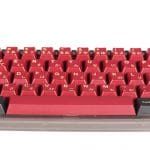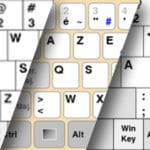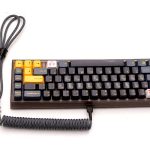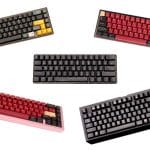
Keyboard plates come in various materials, such as POM, brass, steel, and polycarbonate. The variety of materials in keyboard plates allows for a great range of customization for the keyboard user. However, if you’re looking to customize your typing experience further without purchasing a new plate, going half-plate or plateless is another option to personalize your mechanical keyboard and its respective typing experience.
Going half-plate, where the plate is removed from the alpha keys, or plateless, wherein you fully remove the plate from your keyboard, can improve the flex of the keyboard. It can also reduce the harsh bottom out, resulting in a softer typing experience. This mod is usually recommended for advanced users.
Of course, like any other keyboard modification, this depends on the user’s personal preference and keyboard build. Generally, stiffer keyboards such as tray-mounted keyboards will benefit most from removing the keyboard plate, whether completely or partially.
If you’re still undecided on whether or not you should implement this plate mod, fret not. In this article, we will be taking you through the pros and cons of plateless and half-plate mounting. We will also be discussing the mounting’s effects on your overall keyboard build.
Why are Keyboard Plates Important?

Before we talk more about plateless and half plate keyboard builds, let us first discuss the role of keyboard plates. Using a plate in a keyboard allows for a more stable typing experience. The plate keeps the switches aligned.
Also, using a keyboard plate avoids the switches wobbling from left to right during keypresses. This feature is especially important when using hot-swap PCBs. In hot-swap PCBs, switches tend to wobble more than switches on solder-only PCBs.
Another use case for keyboard plates is when using plate-mount stabilizers and switches. As their name implies, both plate mount stabilizers and plate mount switches will not work if a keyboard does not have a plate. These stabilizers and switches are usually found in budget/pre-built mechanical keyboards.
Lastly, the keyboard plate reduces stress from the keyboard switches meeting the PCB, allowing for a firmer and more consistent typing experience.
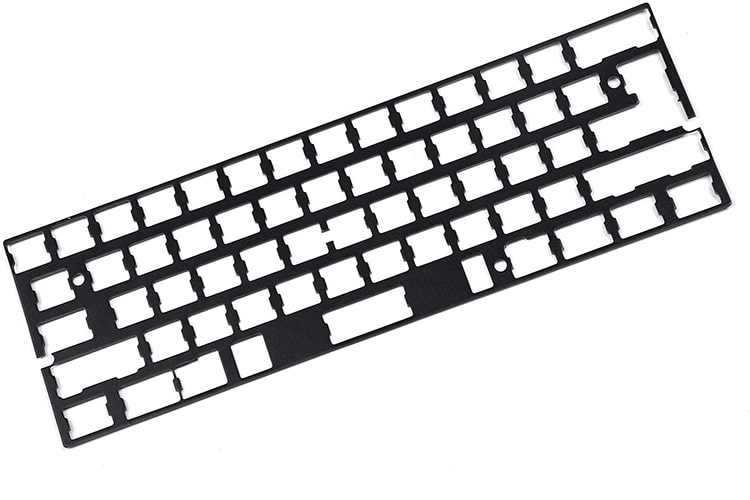
Why are Some Enthusiasts Experimenting With Half Plate and Plateless Builds?
Not everyone wants a firm typing experience. In tray-mounted keyboards especially, having a keyboard plate can be detrimental to the keyboard’s typing feel.
Experimenting with half-plate and plateless builds provides more flex to keyboards that produce a stiffer typing experience. Reducing the surface area of a keyboard’s plate can also help keyboard users looking for more flex, even if their keyboard plate already has flex cuts.
Going plateless can also be an option for keyboard hobbyists looking to reduce the costs of their custom keyboard build. It can be hard to find a plate custom-fit to your PCB, especially in unique layouts like Alice Keyboards, split keyboard layout, or other ergonomic builds. If your keyboard kit doesn’t come with plates already, going plateless is the cheaper and more time-efficient option than looking out for and acquiring a new plate made to fit your board.
Plateless Mounting
Plateless mounting does away with the use of a keyboard plate completely. This can be useful if you’re looking for a more muted build alongside a more flexible typing experience.
We recommend trying out plateless mounting only on keyboards with soldered on switches or 5-pin hot-swap sockets paired with 5-pin switches for a consistent typing feel. Furthermore, you would need PCB-mounted screw-in stabilizers to attempt going fully plateless.
Reddit user u/SwordLaker delved into the nitty-gritty of plated vs. plateless keyboards by comparing identical builds of the GH60 keyboard, one being plateless and another plated. They concluded that the difference between plated builds and plateless builds was negligible unless you’re looking for specific qualities that come from either type of build.
Plateless Keyboard Builds – Pros & Cons
Typing Feel

Most users of the plateless keyboard build report increased flexibility and softness of typing feel in their respective keyboards. However, other users (especially smaller layouts such as the 60% and 40%) report that the typing feel does not differ when removing the keyboard plate.
Sound Profile
Perhaps the keyboard’s sound profile is the most significant and most observable difference in comparing plated and plateless builds. Having keyboard plates in between the switches and the PCB produces more resonant sounds because the plate can bounce off vibrations from the switches’ contact quicker and better than the PCB. However, if you’re looking to create a more quiet and muted sound profile from your keyboard build, then going plateless can be a great option for you.
Durability
As mentioned earlier, the keyboard plate provides a firm cushioning for the switches. For every keystroke, losing the plate may mean that the switches’ housings directly hit the PCB. This is especially important to note for firm and forceful typers or those who prefer heavier springs.
The durability of your keyboard’s PCB may suffer if you’re a strong typer, but you prefer switches with lighter springs. Combining these factors would mean a higher likelihood of your switches directly hitting the PCB and thus damaging the PCB after prolonged use.
However, this is just a precaution to keep inside your mind if you’re doing this mod. As with all other keyboard modifications, there is a higher risk of damaging a keyboard’s durability and even its warranty, should that still be a factor in your keyboard build.
Half-Plate Mounting
For keyboard users with plate-mounted stabilizers, half-plate mounting is the top-tier choice in plate modification. This type of plate mounting style can give you maximum keyboard flex without having to switch your stabilizers to PCB-mounted screw-ins. We recommend this mounting style if you’re still looking for a consistent feel alongside that sought-after soft typing experience without shedding extra costs.
In half-plate mounted keyboards, the plate is cut to fit only the top row and the keyboard’s modifiers. This reduction of surface area in the plate allows increased flexibility in the alpha key cluster of your keyboard. Implementing this type of plate mounting will likewise affect the sound profile of your keyboard since the alpha keys will not create as much reverberation. Thus, the sound profile of half-plate mounted keyboards will be quieter compared to plated keyboard builds.
Compared to plateless keyboards, half-plate mounting is much easier to implement since it accommodates both PCB screw-in and plate-mounted stabilizers. Moreover, it’s a better fit for more strenuous and intense typists since the switches of the modifier keys and the top row would still have some cushion from hitting the PCB directly.
Half-Plate Keyboard Builds – Pros & Cons
Typing Feel
Half-plate mounted keyboards provide a softer typing feel with an increased consistency than plateless keyboards, especially in the keyboard’s modifier keys. Like in plateless keyboards, the additional flex provided by going half-plate may be much more noticeable for keyboards with a larger layout, such as full-sized keyboards.
Sound Profile
Half-plates on keyboards grant a much more muted auditory experience than fully plated keyboards. This half-plate mounting style can be an option for keyboard hobbyists with no budget to acquire a plate made of a different material, but they still seek to dampen the sound profile of their keyboard by a small margin.
Durability
The effect of the half-plate mounting style on your keyboard’s durability is similar to that of the plateless build. The only difference is that half-plates still provide some cushion on the surface area with modifiers and the top row keys.
Going the half-plate route is better in terms of durability, but only by a small margin compared to plateless builds.
Which of the Two is Better?
Both plateless and half-plate mounting styles provide more flex than your average plated keyboard, but how do you choose which one is the best for you and your own keyboard build? Going plateless or half-plate in your keyboard build is the way to go if you’re looking for a more muted acoustic experience from your keyboard, alongside the flex mentioned above.
Plateless keyboard builds are very cost-effective if your kit does not have its own plate for switches. The difference between plated and plateless keyboard builds is negligible, especially in smaller form factors.
Half-plate keyboard builds are good to experiment with if you have plate-mounted stabilizers, but you are looking for a softer typing experience. Depending on your plate’s material, you can cut the plate’s surface for alpha keys on your own or assist the help of more experienced cutters or more advanced tools.
However, if you’re looking for more resonant or louder sound profiles, then building a plated board is best for you. For other styles of plate mounting, you may visit our dedicated Keyboard Plate Article.
Stephen is the head content creator of Keyboardsexpert. His mechanical keyboard journey began in 2014 when he got his Razer Blackwidow. Since then, he has been fascinated with all things mechanical keyboard-related. He later discovered the custom keyboard hobby and fell in love with the vast customization options. He is currently searching for his endgame and is very excited to share his journey and educate other keyboard enthusiasts.
